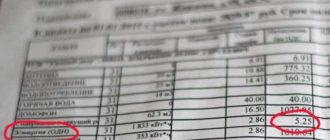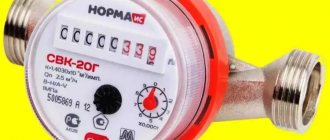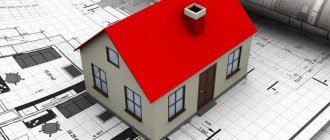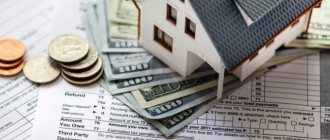Why do you need a communal metering device?
A common house metering device allows you to monitor the actual consumption of resources within the house and record the actual volumes of supplied resources - water, electricity, gas and heat. Therefore, first of all, ODPU is established in order not to overpay for the volume of losses on the supplier’s backbone networks.
Utility costs are determined by 2 factors: the volume of resource consumed and approved tariffs. Tariffs for housing and communal services grow every six months, and the consumer has no opportunity to influence their growth. However, by influencing the second factor - the volume of resource consumed, the management company and apartment owners have a real opportunity to save costs.
Installing ODPU allows you to:
- pay for resource consumption after the fact;
- to differentiate losses for losses on backbone networks between RSO and owners;
- record the loss of resources.
Thus, the presence of ODPU is the only way to determine the real consumption of resources in the house.
Is a communal meter needed if apartments have individual metering devices?
If individual metering devices (IMU) are installed in apartments, the owners pay for what they actually consumed. However, in addition to individual consumption, receipts for payment for utilities also include general household expenses (CHO).
What is ODN and how is it calculated?
Ideally, the category of general house expenses should include resource consumption for maintenance of common house areas. But in practice, this category includes the entire resource that was not taken into account by individual metering devices - including all kinds of leaks. As a result, the volume of resource written off in the ODN column can grow to abnormal sizes of 30% of individual consumption and more. While “normal” is considered an ODN not exceeding 1.5-2%.
In the absence of a common house meter, it is impossible to determine where the leaks are. They can be both in the system of the house itself, and in networks from the resource organization to the house.
The presence of general house accounting makes it possible to pay only for the resource that was actually supplied to the house.
The presence of a common house meter in itself does not save you from an overestimated ODN - there are still leaks inside the house itself and about a dozen other reasons that influence the growth of this expense item.
Large ODP for water: causes and methods of reduction
However, installing a common house meter is the first step towards reducing costs.
In which houses is it necessary to install a common house meter?
The installation of common house metering devices depends on the degree of improvement of the house. Household meters for water, electricity, gas and heat must be in houses connected to centralized power supply networks, as well as to the systems:
- centralized heating;
- centralized water supply;
- centralized gas supply;
- other systems of centralized supply of energy resources.
However, such requirements do not apply to dilapidated, emergency facilities, and to facilities in which:
- power consumption of electrical energy is less than 5 kW⋅h;
- the maximum volume of thermal energy consumption is less than two tenths of Gcal/h;
- The maximum volume of natural gas consumption is less than 2 m³/h.
Whose responsibilities include installation of ODPU
As in any matter related to the provision of public services, there are responsible persons, that is, those who must install communal meters in an apartment building.
To determine the answer to this question, you need to take into account the deadline specified in the legislation - July 1, 2021. Until this moment, the responsibility for installing ODPU lay with the owners of the premises. After this date, responsibility passed to the service organizations. It is they who will be fined for failure to comply with the requirements of the law.
The maintenance company informs residents in advance of the conditions and procedure for installing the devices, and after that enters into an agreement with the company that installs the meters.
Sequence of actions when installing ODPU
Only enterprises that have the necessary permits, knowledge and tools should install heating equipment, since this process is quite labor-intensive.
To install the meter you need to go through the following steps:
- Making a decision on the need to install ODPU.
- Selecting the organization that will carry out the installation of the device.
- Determining the installation location of the ODPU and inspecting it.
- Obtaining technical conditions for installing the device. You can obtain such papers from the resource supplier company.
- Development and approval of design and estimate documentation for meter installation. This is what the design organization does.
- Drawing up and coordination of papers with the resource supplier.
- Purchase of equipment.
- Installation of a common house meter.
- Startup and configuration work.
Who pays for the installation of communal metering devices?
In accordance with the Federal Law “On Energy Saving”, the cost of installing ODPU falls entirely on the owners of a residential building.
Owners of premises are required to pay the costs of installing a common house meter on the basis of invoices, except for cases where such costs were taken into account as part of the fee for the maintenance and repair of residential premises and (or) as part of mandatory payments and (or) contributions associated with the payment of expenses for maintenance, current and major repairs of common property.
RF PP dated August 13, 2006 No. 491, clause 38(1)
When installing common house metering devices, each owner is presented with an invoice for payment, which, in addition to general information about the cost of the metering device, contains information about how much a specific owner must pay.
The expenses of each owner are determined in the form of a share proportional to the share in the right of common ownership of the common property. To calculate this share, the total area of the premises is divided by the total area of the house and multiplied by the area of the common property.
For example, if the area of the premises is 100 m², the area of the house is 9,000 m², and the total property is 1,500 m², then the owner’s share will be: 100 / 9,000 x 1,500 = 16.67 m².
Is it necessary to hold a general meeting of owners?
From the “Rules for the maintenance of common property in an apartment building” it follows that shared property is common property. In particular, such meters are part of in-house engineering systems. Therefore, to install the ODPU, a decision of the general meeting of premises owners is required. The management company must inform the owners of the need to hold such a meeting.
Despite the fact that the role of the management company during the general meeting is limited only to introductory events, if the owners are not notified of the need to install metering devices, the management company faces a fine.
According to paragraph 5 of Article 9.16 of the Code of Administrative Offences, if the organizations responsible for the maintenance of apartment buildings avoid developing and communicating information about measures aimed at energy saving to homeowners, the controlling body in relation to the management company, the homeowners association will be sent an order to impose administrative liability in the form of a fine :
- for an official in the amount of 5,000 to 10,000 rubles;
- for a legal entity – from 20,000 to 30,000 rubles.
How do owners pay for the installation of communal metering devices?
Payment for installation of ODPU is made in one of the following ways:
- Make a one-time 100% deposit before or after installing the meter.
- Use the right to installments for 5 years. In this case, the owner’s share for paying for a common house meter is billed on the utility bill in equal installments over a period of 5 years. In this case, in addition to the cost of the device, an additional interest for installments is paid in the amount of the refinancing rate of the Central Bank of the Russian Federation.
- Use funds from the utility service provider allocated for energy saving and energy efficiency measures.
Funds allocated for energy saving measures
In accordance with Decree of the Government of the Russian Federation No. 354 of 05/06/2011 “On the provision of utility services to owners and users of premises in apartment buildings and residential buildings,” the provider of utility services must direct the resulting difference between the standard and the amount, taking into account the increasing factor, to energy saving measures.
Since the difference between the standard and the amount, taking into account the increasing factor, can only be used for energy saving measures, such funds have a targeted nature of spending, and according to accounting rules, it is necessary to ensure their separate accounting and storage from other income.
Let's look at an example. Let’s say the standard volume of water per person per month is 7 m³. The increasing coefficient in 2021 is 1.4. With a tariff of 14.63 rubles. for 1 m³, we get the following: 7 x 1.4 x 14.63 = 143.37 rubles.
In this case, the amount without standards would be as follows: 7 x 14.63 = 102.41 rubles.
Thus, the difference between the standard and the amount taking into account the increasing coefficient for water is: 143.37 - 102.41 = 39.96 rubles. It is this amount that should be allocated by the contractor for energy saving measures.
The installation of a common house metering device is considered an energy saving measure, therefore, if the owners of an apartment building decide to install a metering device and there are target savings in the account of the utility service provider, they must be used to pay for the installation of the metering device.
If owners refuse to pay for installation
If the owners refuse to pay for the installation of ODPU, such devices will be forcibly installed by the resource supply organization.
In accordance with clause 12 of Article 13 of the Federal Law “On Energy Saving”, owners are obliged to provide RSO employees with access to the installation sites of meters and pay the costs of installing metering devices. In case of refusal to reimburse the resource supplying organization for installation costs, the owners will additionally have to pay the costs associated with forced collection.
Why installation work is not carried out using current repair funds
Current repairs are timely planned preventive maintenance of utility systems, the main way to eliminate malfunctions and minor damage. The purpose of routine repairs is to protect property from premature wear and tear.
In accordance with the “Methodological manual for the maintenance and repair of housing stock” (MDK 2–04.2004), the cost of current repairs of a building should be at least 0.4 - 0.55% of its replacement cost. Inappropriate spending of current repair funds violates the schedule of planned preventative repairs, systematic failure of which can lead to an emergency, sudden failure of pumping equipment, collapse of utility facilities, as well as disruption of the functionality of building elements and energy metering units.
It is permissible to carry out work on the installation of ODPU at the expense of current repair funds if the property is in satisfactory condition. But, as a rule, the physical wear and tear of the housing stock is 70–80% and requires reconstruction.
Compliance with the schedule for scheduled maintenance is the main condition for the environmental and technical safety of residents living in the house. Therefore, in practice, payment for the installation of common house metering devices occurs either at the expense of the owners, or from separate targeted savings for energy saving at home.
Replacing a failed ODPU is work on the maintenance and current repair of common property
After installation, the ODPU is included in the general property of the apartment building and the organization that manages the building or the HOA is responsible for its working condition (Article 36 of the Housing Code of the Russian Federation, clauses 5-7 of the RF PP No. 491, clause 18 of the RF PP No. 290).
Its maintenance and repairs must be planned by the management as part of the work on maintaining the common property of the owners of premises in the apartment building and carried out at the expense of the funds that the residents of the house pay monthly for the maintenance of the residential premises (clause 5, part 1.1, article 161 of the Housing Code of the Russian Federation, resolution of the Presidium of the Supreme Arbitration Court RF dated September 29, 2010 No. 6464/10).
If a common house heat meter fails, then its functionality and technical characteristics must be restored no later than two months after the fact of the breakdown has been recorded (Part 12, Article 13 No. 261-FZ).
The work of the management authority to maintain the ODPU in proper condition includes not only repairing the meter if it is faulty, but also replacing it if it is impossible to restore the functionality of the device through partial repairs. In this case, a report on the failure of the ODPU is drawn up.
Features of repair and maintenance of ODPU by management organizations
318804
How much does installation cost?
It is equally important for owners to know who should pay more for the installation of ODPU and who should pay less. Interestingly, the number of residents registered in the apartment does not affect the cost of installation at all. Each person’s consumption is calculated based on the proportional ratio of the apartment’s area to the total area of the entire house. The calculation also takes into account the area of the total property of the house, which represents all non-residential premises of the building.
Thus, the area of a particular apartment is divided by the total area of the house, after which the result is multiplied by the area of non-residential premises of the entire building - common property in the form of staircases and so on.
The result obtained is multiplied by the cost of the device and its installation; if necessary, the amount is divided by 60 to determine the amount of monthly installment payments.
Who services public meters?
Since the installation of the ODPU was jointly paid for by all the owners of the premises, the device is their common property, intended to serve the needs of the entire house. This is confirmed by the provisions
Thus, the maintenance of communal metering devices in apartment buildings is the responsibility of the residents, which is performed on their behalf by a management organization or homeowners’ association.
There are strict requirements for maintenance (Article 36 of the Housing Code of the Russian Federation):
- compliance with the conditions of safety and security at home;
- guarantee of safety for life and health of residents;
- accessibility to use the premises;
- respect for the rights of owners;
- maintaining utility networks and metering devices in working order;
- compliance with legislative requirements on energy saving.
So, verification of common house metering devices in apartment buildings falls within the competence of the management organization, if a management agreement has been concluded, or of the homeowners’ association (according to the Charter).
The procedure for making decisions on installing meters and paying for work
The decision to install the described means must be made by the homeowner or all owners collectively. If there are several of them or we are talking about installing an ODPU for an apartment building.
It is worth understanding that installing counters for any type of consumed resources helps:
- pay for the amount of resources that were actually consumed;
- save on housing and communal services payments, since recalculations due to the loss of resources “on the way” to the home are eliminated;
- clearly record any loss of resources.
At the moment, the procedure is not mandatory, but in their absence, the government has every right to charge for resources with a slight increase (up to 1.6 of the total amount).
Recent laws regulated the obligation of the housing management company (HMC) to carry out timely and periodic notifications to residents of both private and apartment buildings so that they consider installing such a device.
Advantages and disadvantages of installing ODPU
There are both positive and negative aspects to using ODPU. The undoubted advantages include the possibility of:
- Monitor the amount of resources and services supplied and compare these figures with standard indicators.
- Monitor the serviceability of the systems and the presence/absence of leaks, because in the event of loss of a resource (water, for example), the total indicator of individual meters will be less than the general one.
- Eliminate water losses during mutual settlements with supplying organizations - payment for losses on main networks will not fall on the consumer.
- Pay for the actual service consumed.
There are also quite serious disadvantages. Firstly, there is a new section in the accounts - GDN (general household needs). And although the figure is insignificant, with a large number of residents a substantial amount accrues. The possibility of abuse cannot be ruled out.
Secondly, the installation of such a device forces residents to bear responsibility for each other. This manifests itself as follows: they must pay the difference between the readings of the ODPU and individual meters together. In practice, it looks like this: if the meter in someone’s apartment is faulty, there is a loss of resource somewhere, or someone does not pay their bills, the difference in readings is paid by the remaining owners. It turns out that law-abiding citizens pay out of their own pockets for unscrupulous or absent tenants.
How the ODPU is put into operation
After going through all of the above stages and before starting to pay for utilities according to the meter readings, all that remains is to put it into operation correctly. To do this, it is necessary to draw up a commissioning certificate, inviting representatives of the management organization and the utility service.
After signing the document, you need to seal the meter.
If you do not sign the commissioning certificate, the utility service will not service the meter that is not registered. In this case, maintenance of the device will fall on the shoulders of the homeowners.











